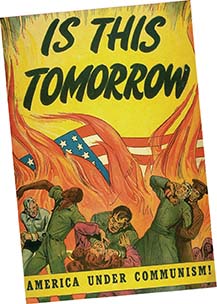SECTION 4: The Cold War at Home

▲ Anticommunist comic
WITNESS HISTORY  AUDIO
AUDIO
Battling the Communist Menace
In the 1950s, Americans were alarmed by charges that communists had infiltrated their government and other institutions. Cold War themes made their way into movies, television shows, and novels. Even comic-book heroes like Superman battled the communist menace. In a 1952 comic book, a character states the concerns of many Americans:
“Today’s headlines shout of battles with Communist hordes in Korea—of Red riots in Rome and Paris and Berlin! But there’s another secret battle taking place—right here, right now! A [secret] underground fight between Communism and democracy for the youth of America.”
—“Backyard Battleground,” in Daring Confessions, 1953
Objectives
- Describe the efforts of President Truman and the House of Representatives to fight communism at home.
- Explain how domestic spy cases increased fears of communist influence in the U.S. government.
- Analyze the rise and fall of Senator Joseph McCarthy and the methods of McCarthyism.
Terms and People
- Red Scare
- Smith Act
- HUAC
- Hollywood Ten
- blacklist
- Alger Hiss
- Julius and Ethel Rosenberg
- Joseph R. McCarthy
- McCarthyism
NoteTaking
Reading Skill: Identify Causes and Effects List efforts taken to protect Americans from communism and how these policies affected rights.
| Anticommunist Policy | Effect on Rights |
|---|---|
Why It Matters Americans have often faced the difficult task of balancing the need to provide national security with the need to protect people’s rights and freedoms. In times of crisis, rights have sometimes been limited. Beginning in the late 1940s, the Cold War dominated American life. For some of those years, the nation was in the grip of a new Red Scare. The hunt for communists netted some spies, but it also disrupted the lives of thousands of innocent Americans. Section Focus Question: How did fear of domestic communism affect American society during the Cold War?
Worrying About Communists at Home
The Cold War influenced many aspects of American life. American soldiers fought and died in Korea. Industries hummed with activity, turning out weapons and supplies. Americans read newspaper articles about who “lost” China or who was winning the “space race.” Popular culture reflected an us-versus-them attitude—democrats versus totalitarians, capitalists versus communists, the West versus the East. In the end, the Cold War was turning out to be every bit as global and as encompassing as World War II had been.
Truman Roots Out Communists
The fear that communists both outside and inside America were working to destroy American life created a reaction known as a Red Scare. This fear was not unique to the late 1940s and 1950s. The 1917 Russian Revolution and the




